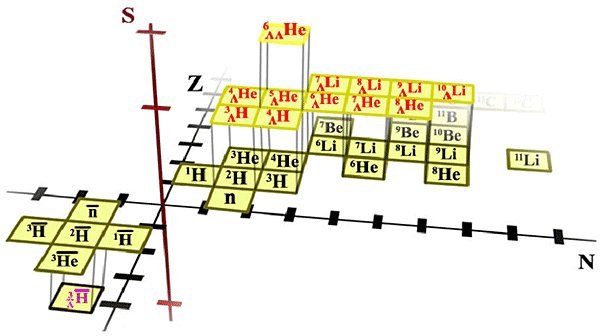
Physicists working in the STAR collaboration at the Relativistic Heavy Ion Collider (RHIC) at the Brookhaven Laboratory in the US have detected antimatter nuclei containing strange quarks for the first time. The antihypertriton – consisting of an antiproton, an antineutron and an antilambda particle – is the heaviest antinucleus yet produced and opens up a new realm of strange antinucluei. It could also shed light on a number of problems in astrophysics and cosmology, including the dominance of matter over antimatter in the universe.
RHIC collides gold ions at high energies, recreating what are believed to have been the conditions in the universe just a few microseconds after the Big Bang. The enormous energy density that existed at that time would have kept quarks separate from one another, in what theory predicts would have been a very hot gas of free quarks, antiquarks and gluons known as a quark–gluon plasma. As the plasma expanded and cooled these quarks would have bound to one another to form a range of different hadrons, including protons and neutrons (consisting solely of up and down quarks), hyperons (which contain strange quarks) and all of the associated antiparticles.
Introducing antihypertriton
With further expansion a small fraction of these hadrons would then have combined to form light nuclei and their antiparticles. Physicists have previously generated antiprotons, anti-deuterium, anti-tritium and anti-helium-3 in particle collisions but the STAR collaboration, led by Declan Keane at Kent State University in the US, Jinhui Chen of the Shanghai Institute of Applied Physics in China and Zhangbu Xu of Brookhaven, have seen the first ever antimatter hypernucleus: antihypertriton. In addition to an antiproton and an antineutron, this nucleus contains an antilambda hyperon, which is made up of an up quark, a down quark and a strange quark.
Identifying the new particle required painstakingly sifting through the debris of some 100 million collisions. All of the charged particles within this debris left their mark by ionizing the gas inside RHIC’s time projection chamber but the antihypertritons revealed themselves through a unique decay signature – the two tracks left by a charged pion and an antihelium-3 nucleus, the latter being heavy and so losing energy rapidly with distance in the gas.
Below the N-Z plane
One of the collaboration members, Lee Barnby of the University of Birmingham in the UK, says that this result “opens up a new area of study” because it shows that “any very light bound nucleus or antinucleus can be formed in heavy-ion collisions”. Indeed, the discovery extends graphically our knowledge of the nuclear terrain. Physicists represent this terrain by placing each kind of nucleus on a three-dimensional graph with the three axes being Z, the number of protons in a nucleus; N, the number of neutrons; and S, the degree of strangeness. Each of these three axes has positive and negative sections, allowing for the representation of both particles and antiparticles. As illustrated in the diagram, this latest result extends the nuclear terrain below the N–Z plane for the first time.
The STAR collaboration’s production of hypernuclei could also help us better understand the structure of the massive-star remnants known as neutron stars. That is because the kind and extent of strange-matter content within these stars depends on how strongly hyperons interact with nucleons (protons and neutrons), and this interaction strength in turn can be worked out by measuring the lifetime of hypernuclei. The current experiment yielded a value of around 2 × 10–10 s for hypertritons.
Why more matter than antimatter?
The findings may also help us understand why the universe appears only to contain matter, whereas equal quantities of matter and antimatter were believed to have been created in the Big Bang. Quarks and antiquarks are generated in equal measure by the heavy-ion collisions at RHIC and this equal abundance of matter and its antimatter partner is observed to persist as the hot gas cools.
The research is a tour-de-force of analysis and highlights the immense power of modern particle physics detector technologies and techniques Mike Charlton, Swansea University
In addition, the number of hypertritons and antihypertritons produced in the RHIC collisions (about 160 and 70 respectively) very closely matched the number of helium-3 and antihelium-3 nuclei generated. Mike Charlton of Swansea University in the UK, who is not a member of the STAR collaboration, points out that this implies that the hot gas must have contained similar amounts of strange quarks and up and down quarks. This, he says, is an indication that the gas is indeed a true quark–gluon plasma, as physicists believe. “The research is a tour-de-force of analysis and highlights the immense power of modern particle physics detector technologies and techniques,” he adds.
The STAR collaboration has restarted its antimatter observations at a higher collision rate, hoping to increase their collected data by a factor of 10 over the next few years. Keane says that this should allow them to discover yet heavier antinuclei, both strange and non-strange.
The work is described in Science DOI: 10.1126/science.1183980.



